Post Conference Excursion
Sunday, October 6 2019

Visit to the working archaeological excavation of the Acropolis of Eleutherna (Sector II), Orthi Petra (Sector III) and to Museum of the Archaeological Site. Please make sure that you wear sport shoes
Note: The visit to the archaeological site is dependent upon weather conditions. In case of rain we will visit the Museum
Lunch is optional
Departure from Rethymnon: 9.00
Arrival to Rethymnon: 17.00
Eleutherna, which lies 25 km southeast of Rethymno is an ancient city-state that flourished from the Dark Ages of Greece’s early history until Byzantine times.The Department of History and Archaeology of the University of Crete has been excavating the site for 30 years now.
We will visit Eleutherna Excavation at the Acropolis-Pyrgi (Sector IΙ), the archaeological site of Orthi Petra (Sector III) as well as the Museum of the Archaeological Site.
Eleutherna- Acropolis (Pyrgi)
Ass. Prof Christina Tsigonaki, director of the excavation Sector IΙ will provide us with exclusive access to the working archaeological excavation and will introduce us to the history of the site and the excavation process.
Sector IΙ of the excavation extends from the highest reaches of Pyrgi and Nissi, two hills which dominate the landscape at Ancient Eleutherna.
Research has been conducted since 1985 under the supervision of Thanassis Kalpaxis, Professor of Classical Archaeology, with the aim of determining what function the areas served within the framework of the town plan.
It has been determined that Nissi hill was mainly used as a residential area from Geometric times or earlier up until the late Hellenistic period, when it was abandoned. A large rectangular enclosure dating to the classical period with a Doric monumental portico was found on the north side of the hill, outside the settlement boundary. The wall surrounds an area occupied by a local sanctuary, possibly dedicated to Apollo Sassthraios.
Pyrgi hill is a naturally fortified position, and was used almost continuously from Proto-Minoan to Late Byzantine times.
The Archaic temple unearthed on the central plateau testifies to the fact that it was the main acropolis of the ancient city. This is further confirmed by the remains of other Doric rhythm buildings, as well as by the large number of inscriptions from the Archaic, Classical and Hellenistic periods, and the existence of an Early Christian house of worship. Nevertheless, over time a considerable expanse served as a residential area, probably during particularly troubled phases in the city history.
The defensive tower on the north side of the hill gave rise to its name (Greek pyrgi = tower.) This was built in Early Byzantine times, as were the other visible sections of the fortifications and the large cisterns on the west side.

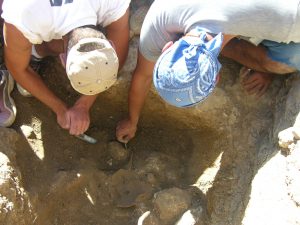
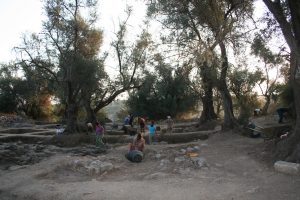
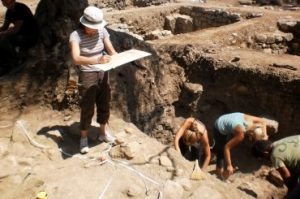
For more information visit: here
Eleutherna- Othi Petra (Sector III)
Τhe archaeological excavation at Orthi Petra (standing stone), under the supervision of Nikolaos Stabolides, Professor of Classical Archaeology, started in 1985 (along with those in Sections I and II) on the West slope of Prines hill (ancient Eleftherna) and expanded onto the East slope of the Eleftherna hill as well as the quarry of Peristeres over the next few years.
At the Orthi Petra site, archaeological activity has led to the discovery of parts of the Hellenistic and Roman city, mainly building foundations, houses and paved roads, movables and other finds from the Late Antiquity and Early Christian Period.
However, the most significant discovery at the same site is that of a cemetery from the Geometric/Archaic Period (from the beginning of the 9th century B.C to the Archaic Period) in which three different burial practices have been observed in the last few years: cremation, inhumation in pithos or amphora, and simple inhumation.
For more information visit: here
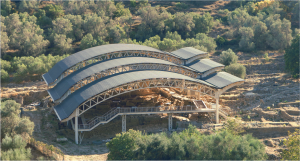
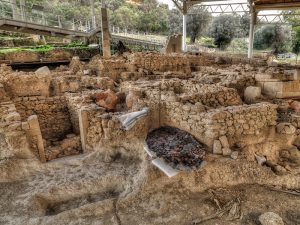
Museum of Ancient Eleutherna
The Museum of ancient Eleutherna – Homer in Crete, the first archaeological site museum in Crete, although smaller in size, is similar to those of Olympia, Delphi, and Vergina. The museum was created to house the results of the excavations carried out in the ancient city of Eleutherna by the Department of History and Archaeology of the University of Crete for thirty years.
The originality of this museum is that the objects of the permanent exhibition will be updated periodically with new and older finds, so that the public’s interest is continuous and relates to the discoveries and expansion of the excavation work on the site.
The exhibition is accompanied by original and modern audiovisual exhibits.
For more information please visit: here

